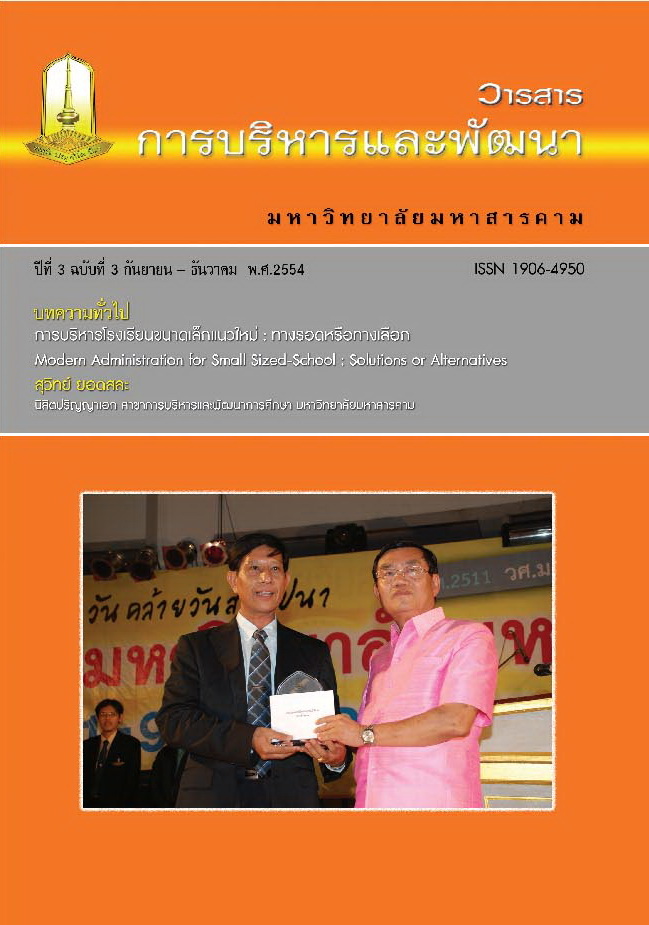การเปรียบเทียบผลสัมฤทธิ์ทางการเรียน เรื่องเวลา ความสามารถในการคิด วิเคราะห์และความรู้สึกเชิงจำนวน ของนักเรียนชั้นประถมศึกษาปีที่ 2 กลุ่มสาระ การเรียนรู้คณิตศาสตร์ระหว่างการจัดกิจกรรมการเรียนรู้แบบ 4 MAT และการ จัดกิจกรรมการเรียนรู้แบบปกติ
Main Article Content
Abstract
บทคัดย่อ
การจัดกิจกรรมการเรียนรู้แบบวัฏจักรการเรียนรู้ 4 MAT เป็นหนึ่งในรูปแบบการจัดการ เรียนรู้ที่ช่วยส่งเสริมให้ผู้เรียนมีการพัฒนาสมองซีกซ้ายและขวาอย่างเป็นระบบและสมดุล ทำให้ผู้ เรียนมีการเรียนรู้ตามศักยภาพ การวิจัยครั้งนี้มีความมุ่งหมายเพื่อพัฒนาแผนและการจัดกิจกรรม การเรียนรู้โดยใช้กิจกรรมการเรียนรู้แบบ 4 MAT และแบบปกติ เรื่องเวลา ชั้นประถมศึกษาปีที่ 2 ที่มีประสิทธิภาพตามเกณฑ์ 75/75 เพื่อศึกษาดัชนีประสิทธิผลของแผนและการจัดกิจกรรมการ เรียนรู้ เพื่อเปรยี บเทยี บผลสมั ฤทธิ์ทางการเรียน เรือ่ งเวลา ความสามารถในการคดิ วเิ คราะห ์ ความ รู้สึกเชิงจำนวน ระหว่างก่อนและหลังเรียน โดยการจัดกิจกรรมการเรียนรู้แบบ 4 MAT และแบบ ปกติ และเพื่อเปรียบเทียบผลสัมฤทธิ์ทางการเรียน เรื่องเวลา ความสามารถในการคิดวิเคราะห์ ความรู้สึกเชิงจำนวน ระหว่างกลุ่มที่เรียนโดยการจัดกิจกรรมการเรียนรู้แบบ 4 MAT และแบบ ปกติ กลุ่มตัวอย่างที่ใช้ในการวิจัยเป็นนักเรียนชั้นประถมศึกษาปีที่ 2 โรงเรียนบ้านหนองบัวเงิน หนองบัวทอง จำนวน 31 คน และนักเรียนโรงเรียนบ้านหนองตะไก้ จำนวน 34 คน ภาคเรียนที่ 2 ปีการศึกษา 2553 ซึ่งได้มาโดยการสุ่มแบบกลุ่ม แล้วจับสลากเพื่อกำหนดเป็นกลุ่มทดลองและ กลุ่มควบคุม ซึ่งได้โรงเรียนบ้านหนองบัวเงินหนองบัวทอง เป็นกลุ่มทดลอง และโรงเรียนบ้าน หนองตะไก้เป็นกลุ่มควบคุมเครื่องมือที่ใช้ในการวิจัย ได้แก่ แผนการจัดกิจกรรมการเรียนรู้แบบ 4 MAT และแผนการจัดกิจกรรมการเรียนรู้แบบปกติ กลุ่มสาระการเรียนรู้คณิตศาสตร์ เรื่องเวลา อย่างละ 9 แผน ใช้เวลาสอน แผนละ 1 ชั่วโมง แบบทดสอบวัดผลสัมฤทธิ์ทางการเรียน เรื่อง เวลา จำนวน 20 ข้อ มีค่า อำนาจจำแนกรายข้อ (B) ตั้งแต่ 0.25 ถึง 0.70 ค่าความเชื่อมั่นของ แบบทดสอบทั้งฉบับ (rcc) เท่ากับ 0.87 แบบทดสอบวัดความสามารถในการคิดวิเคราะห์ จำนวน 20 ข้อ มีค่าความยากตั้งแต่ 0.25 ถึง 0.66 ค่าอำนาจจำแนกรายข้อ (rxy) ตั้งแต่ 0.28 ถึง 0.69 ค่าความเชื่อมั่น (KR-20) ทั้งฉบับ เท่ากับ 0.85 และแบบทดสอบวัดความรู้สึกเชิงจำนวน จำนวน 20 ข้อ มีค่าความยาก (p) ตั้งแต่ 0.25 ถึง 0.69 ค่าอำนาจจำแนกรายข้อ (rxy) ตั้งแต่ 0.34 ถึง 0.78 ค่าความเชื่อมั่นทั้งฉบับ (KR-20) เท่ากับ 0.89 สถิติ ที่ใช้ในการวิเคราะห์ข้อมูล ได้แก่ ร้อย ละ ค่าเฉลี่ย ส่วนเบี่ยงเบนมาตรฐาน และทดสอบสมมุติฐานโดยใช้สถิติ t – test (Dependent Samples) และ Hotelling’s - T2
ผลการวิจัยปรากฏดังนี้
1. แผนการจัดกิจกรรมการเรียนรู้แบบ 4 MAT และแบบปกติ เรื่องเวลา ชั้นประถมศึกษา ปีที่ 2 มีประสิทธิภาพ 83.52/82.72 และ 75.95/75.16 ตามลำดับ ซึ่งเป็นไปตามเกณฑ์ 75/75 ที่ตั้งไว้
2. ค่าดัชนีประสิทธิผลของแผนการจัดกิจกรรมการเรียนรู้แบบ 4 MAT และแบบ ปกติ เรื่องเวลา ชั้นประถมศึกษาปีที่ 2 เท่ากับ 0.7035 และ 0.6041 หรือคิดเป็นร้อยละ 70.35 และ 60.41 ตามลำดับ
3. ผลสัมฤทธิ์ทางการเรียนของนักเรียนที่เรียนโดยการจัดกิจกรรมการเรียนรู้แบบ 4 MAT และแบบปกติ หลังเรียนสูงกว่าก่อนเรียนอย่างมีนัยสำคัญทางสถิติที่ระดับ .05
4. ความสามารถในการคิดวิเคราะห์ของนักเรียนที่เรียนโดยการจัดกิจกรรมการเรียน รู้แบบ 4 MAT และแบบปกติ หลังเรียนสูงกว่าก่อนเรียนอย่างมีนัยสำคัญทางสถิติที่ระดับ .05
5. ความรู้สึกเชิงจำนวนของนักเรียนที่เรียนโดยการจัดกิจกรรมการเรียนรู้แบบ 4 MAT และ แบบปกติหลังเรียนสูงกว่าก่อนเรียนอย่างมีนัยสำคัญทางสถิติที่ระดับ .05
6. นักเรียนที่เรียนโดยการจัดกิจกรรมการเรียนรู้แบบ 4 MAT มีผลสัมฤทธิ์ทางการ เรียน เรื่องเวลา ความสามารถในการคิดวิเคราะห์ และความรู้สึกเชิงจำนวนสูงกว่านักเรียนที่เรียน แบบปกติ อย่างมีนัยสำคัญทางสถิติที่ระดับ .05
คำสำคัญ : ผลสัมฤทธิ์ทางการเรียน, ความสามารถในการคิดวิเคราะห์, ความรู้สึกเชิงจำนวน, กิจกรรมการเรียนรู้แบบ 4 MAT, กิจกรรมการเรียนรู้แบบปกติ
Abstract
Organization of 4 MAT cycle learning activities is one of teaching models which can help promote learner to have development of the left and right hemispheres to be systematic and balanced and can cause learners to learn according to their potentials. This research aimed to develop the lesson plans of the 4 MAT Model Instruction and the Conventional Instruction. Entitled “Time” with the efficiency criteria of 75/75, to find out the effectiveness index of the lesson plans of the 4 MAT Model Instruction and the Conventional Instruction, to compare learning achievement entitled “Time”, Analytical thinking and Number Sense in Mathematics of Prathomsuksa 2 students between before and after learning used the 4 MAT Model Instruction and the Conventional Instruction, to compare learning achievement entitled “Time”, Analytical thinking and Number
Sense in Mathematics of students between learned by using the 4 MAT Model Instruction and by using the Conventional Instruction. The sample used in this study were divided into 2 group were 1) an experimental group was 31 Prathomsuksa 2 students attending Nongbua-ngurng Nongbua-thong School and 2) a control group was 34 Prathomsuksa 2 students in Nong-ta-kai School, Tumbol Nong Pai, Muang District, The Primary Education Office in Udon Thani Area 1 in the second semester of the academic year 2010, obtained by using the Cluster Sampling technique. The research instruments were : 9 mathematics lesson plans for students learned using the 4 MAT Model Instruction and the Conventional Instruction ; a 20-item achievement test with ranging .31 to .77, discriminating powers (B) ranging .25 to .70, and a reliability (rcc) of 0.87 ; a 20-item Analytical thinking test with difficulties ranging .25 to .66, discriminating powers (rxy) ranging .28 to .69, and a reliability (KR-20) of .85 ; and a 20-item Number Sense test with difficulties ranging .25 to .69 ,discriminating powers (rxy) ranging .34 to .78, and a reliability (KR-20 ) of .89. The collected data were analyzed by percentage, mean and standard deviation, t–test (Dependent Sample) and Hotelling’ T2 were employed for testing hypotheses.
The results of the study were as follows :
1. The plans for organization of 4 MAT cycle leaning activities and the plans for organization of traditional learning activities entitled Time for Prathomsueksa 2 students had efficiencies of 83.52/82.72 and 75.95/75.16 respectively which were in conformity with the established requirement of 75/75.
2. The effective indices of the plans for organization of 4 MAT cycle learning Activities and the plans for organization of traditional learning activities entitled time for Prathomsueksa 2 were 0.7035 and 0.6041.
3. The students who learning by organization 4 MAT Model Instruction and the Conventional Instruction had learning achievement after learning higher than
before learning at the .05 level of significance.
4. The students who learning by organization 4 MAT cycle learning activities entitled Time in the mathematics learning strand had higher learning achievement than those who learned by organization of traditional learning activities at the .05 level of significance.
5. The students who learning by organization 4 MAT cycle learning activities entitled Time in the mathematics learning strand had higher analytical thinking than those who learned by organization of traditional learning activities at the .05 level of significance.
6. The students who learning by organization 4 MAT cycle learning activities entitled Time in the mathematics learning strand had higher number sense than those who learned by organization of traditional learning activities at the .05 level of significance.
Keywords : Comparisons of Mathematics Learning Achievement, Analytical Thinking and Number Sense, 4 MAT Learning Activities and a Traditional Learning Activities

